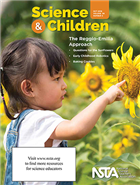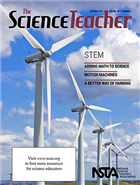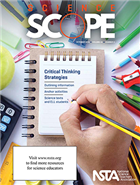Ideas and inspiration from NSTA’s October 2018 K-12 journals
By Mary Bigelow
Posted on 2018-10-15
Many NSTA authors share resources related to the lessons and strategies in their articles. These resources include rubrics, graphic organizers, handouts, diagrams, lists of resources, and complete lessons. You can access these through the Connections link in each journal: Science & Children, Science Scope, The Science Teacher.
Regardless of what grade level or subject you teach, check out all three journals. As you skim through the article titles and descriptions, you may find ideas for lessons that would be interesting your students or the inspiration to adapt a lesson to your heeds or create/share your own.
NSTA members, as always, have access to the articles in all journals! Click on the links to read or add to your library.
 Science & Children – The Reggio Emilia Approach
Science & Children – The Reggio Emilia Approach
Editor’s Note: Promoting Lifelong Learning “This month our feature articles highlight Reggio Emilio as an approach to empower both the educator and students with a mindset that reminds us, teachers of any grade level, that learning starts with engaged students, and engaged students are active in the process and direction of the learning…What do we know about them [students], their thinking, their likes, and dislikes? How can we involve the students in the process of learning? How can we be sure to help promote lifelong learners? These questions are at the heart of the Reggio Emilio approach.”
The lessons described in the articles have a chart showing connections with the NGSS as well as classroom materials, illustrations of student work, and photographs of students engaged in the activities.
- The author of Using Magnetism to Move a Toy Vehicle used a “Kids Inquiry Conference” to encourage students to explore magnetism. The article is a good overview of what the Reggio Emilia approach looks like in a classroom—and includes photos of the young scientists at work. (Note: Your classroom may be quite similar!)
- Baking Cookies goes beyond a traditional cookbook class on following a recipe to a lesson on creating and testing a recipe. The article includes a diagram of a Cycle of Inquiry process and an overview of the Reggio Emilio approach (and a connection with NGSS–the two are compatible!).
- Following the Current illustrates how in PreK, explorations never really end. They become part of a larger experience. The author shares her thoughts on evaluating learning in this open-ended environment, as well as photos of the students at work.
- Questions for the Sunflowers describes a project that incorporates the Reggio Emilio approach with 5E lesson on plant growth
- Children can have authentic learning experiences as they collaborate, create, and communicate on making robots out of Legos. Early Childhood Robotics describes the role of the teacher in facilitating these experiences.
- The Early Years: Creating a Possibility-Rich Classroom Environment has suggestions for providing first-had experiences with natural phenomena and design challenges.
- In addition to recommending trade books, Teaching Through Trade Books: Plants, Animals, and Earth Processes, Oh My! Changes to the Environment has two lessons, Plants and Animals Can Change the World (K-2) and Exploring Erosion (3-5) that help students explore various agents that change the Earth’s habitats.
- Methods and Strategies: A Noteworthy Connection has ideas for science notebooks, including ideas for ELL students.
These monthly columns continue to provide background knowledge and classroom ideas:
- Are you a presenter for workshops or conferences? Check out Teaching Teachers: Create Engaging Workshop Experiences in Five Simple Steps
- The Poetry of Science: Questions, Questions!
- Science 101: What Is “Static Electricity,” and How Can I See Its Effects? (Background booster)
- Engineering Encounters: Engineering a Model of the Earth as a Water Filter
For more on the content that provides a context for projects and strategies described in this issue, see the SciLinks topics Adaptations of Animals, Electricity, Erosion, How Can Matter Be Measured?, Interactions in Matter, Magnets, Parts of a Plant, Physical Properties of Matter, Plant Growth, Soil Layers, States of Matter, Static Electricity, Water Cycle, Water Quality
Continue for The Science Teacher and Science Scope.
 The Science Teacher – STEM
The Science Teacher – STEM
Editor’s Corner: Understanding STEM “STEM programs prepare students for careers in innovation and information economy and make learning more interesting and relevant. They enable our nation’s youth to develop the critical thinking skills required to make informed decisions about public policy, evaluate claims made in the media, talk to their doctors, and manage daily lives that increasingly rely on technology.”
Commentary: The T&E in STEM: A Collaborative Effort looks at recent TST article and how teachers of science, technology, and engineering can (and should) collaborate and learn from each other to provide STEM experiences for students.
The lessons described in the articles include a chart showing connections with the NGSS. The graphics are especially helpful in understanding the activities and in providing ideas for your own investigations.
- The authors of Adding Math to Science updated a unit on frictional force to include mathematics, helping students make sense of the concepts. They include samples of hwo students created, tested, and revised their mathematical models. How could this idea be used in other science topics?
- Motion Machines describes a problem-based learning project in which students create a design plan, a technical drawing, and a working prototpye to explore motion translation and transmission. Photos in the article show student projects.
- In addition to demonstrating the nitrogen cycle in an ecosystem, students using the lesson in A Better Way of Farming explore alternative and sustainable farming methods that can be applied anywhere.
- Severe storms, such as the one that damaged the electricity infrastrucre in Puerto Rico, are becoming more common. Why Not STEM? shows how students can research, design, build, and test model wind turbines as a way of solving power outages.
- Focus on Physics: The Tapered Rims of Train Wheels looks at the physics and engineering of something we take for granted: a smooth and safe train ride. The graphics help to explain the concepts of linear and rotational speed.
- Idea Bank: The Power of STEM has ideas for incorporating STEM activities in high school, resulting in a STEM certificate for students through coursework or extracurriculars.
These monthly columns continue to provide background knowledge and classroom ideas:
Two articles from this month’s Science Scope also address STEM topics:
- Practical Research: From Interest to Identity reviews the literature on students’ STEM identities. The article includes chart of questions and strategies for teacher reflection.
- The challenge presented in Making in the Middle: Engineering Prosthetic Hands is to design and build a working model using everyday materials (and students also learn anatomy and physiology in doing so).
For more on the content that provides a context for projects and strategies described in this issue, see the SciLinks topics Anaerobic Respiration, Aquaculture, Biomedical Engineer, Forces and Motion, Friction, Generators, Gravity, Hydroponics, Machines, Motion, Newton’s Laws of Motion, Nitrogen Cycle, Photosynthesis, Simple Machines, Speed, Sustainable Agriculture, Velocity, Wind Energy
 Science Scope – Critical Thinking Strategies
Science Scope – Critical Thinking Strategies
If you wonder if middle level students can think critically or learn to do so, From the Editor’s Desk: Critical Thinking and the Adolescent Brain notes that the adolescent brain is a developing one. “This ongoing brain development is all the more reason for us to develop engaging activities that require our students to think critically, since what happens in our classrooms can ultimately impact the hardwiring of their brains…we can listen to them and accept them for who they are—imperfect works in progress on whom we have tremendous influence.”
Articles in this issue that describe lessons (many of which use the 5E model) include a helpful sidebar documenting the big idea, essential pre-knowledge, time, safety issues, and cost. The lessons also include connections with the NGSS.
- Even though students may understand and recognize Claim-Evidence-Reasoning progression, creating their own may be a challenge. Dropping Anchor! has strategies to assist students with this challenging task.
- “I hate when that happens.” If your students are frustrated with household tools that don’t always do the job, Integrating Technology: The Innovative Utensil Challenge has a design challenge for students to solve common problems. Check out the visuals of the “Cookie Dunker” and others to see how inventive students can be.
- The challenge presented in Making in the Middle: Engineering Prosthetic Hands is to design and build a working model using everyday materials (and students also learn anatomy and physiology in doing so).
- Practical Research: From Interest to Identity reviews the literature on students’ STEM identities. The article includes chart of questions and strategies for teacher reflection.
- Citizen Science: I See Change: Do You? is an opportunity for students to participate in a worldwide study of weather and climate change.
- Interdisciplinary Ideas: Project GUTS provides ideas for integrating computational science into middle school science classrooms. The article focuses on students using (and creating) computer models to understand phenomena. (And teachers do not have to be computer whizzes to use the project described in the article.
Several articles address issues in reading, processing, and writing science text:
- With the skill of Outlining Informational Text, students can organize information into a hierarchical format for more in-depth analysis and communication. This article provides several strategies for helping students develop this skill, including examples and templates.
- Science For All: Demystifying Reading in the Science Classroom includes many suggestions for content-area literacy to help students make sense of written information.
- The strategies described in English Learners and the Complex Language of Written Science Texts can be used to support ELL students as well as struggling readers. The strategies focus on helping students process nominalizations (when verbs are converted to nouns) and connecting words showing the relationships between ideas.
These monthly columns continue to provide background knowledge and classroom ideas:
- Disequilibrium: Egg in a Bottle
- Scope on the Skies: Milestones in Space Exploration (including the 60th anniversary of NASA)
- Teacher’s Toolkit: The Argumentation Toolkit
For more on the content that provides a context for projects and strategies described in this issue, see the SciLinks topics Biomedical Engineer, Climate Change, Communications Skills, Compound Machines, Endangered Species, Fossil Discoveries, Pressure, Reading and Writing in Science, Skeletal and Muscular Systems, Space Exploration, Weather and Climate
Disclaimer: The views expressed in this blog post are those of the author(s) and do not necessarily reflect the official position of the National Science Teaching Association (NSTA).


